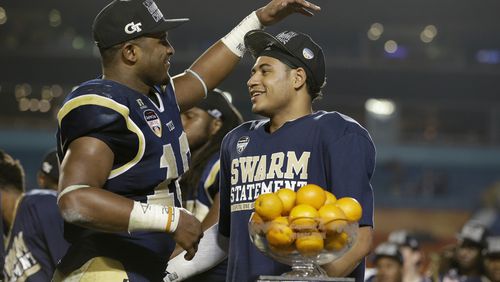As Georgia plays Alabama Monday night for the national championship, the question may cross the mind of Georgia Tech fans – will the Yellow Jackets ever be in that position again, to play for the title of nation’s best?
There is reason to be pessimistic, perhaps even highly so. Tech has now missed a bowl game twice in three seasons. The 2017 team showed promise and had a chance to be special, but in the end was not a team that accomplished anything of significant merit beyond beating Virginia Tech for the second year in a row.
Two teams permanently on the Yellow Jackets’ schedule, Clemson and Georgia, have perched themselves among the elite of the elite and don’t look like they’ll be leaving anytime soon.
In the Coastal Division, Virginia Tech and Miami appear to have restored themselves to perennial top-25 status. Always stocked with solid recruiting classes, North Carolina should be more competitive in years to come than this season. Duke has become a legitimate peer, winning three of the past four. Virginia and Pitt have both beaten Tech two of the past three seasons.
As has been noted widely, the ACC has become a significantly rougher neighborhood, and the Jackets can testify as well as anyone.
Further, given Tech’s commitment to trying to play two power-conference opponents annually in the nonconference schedule (Georgia being one), there’s always opportunities to trip up, as happened this season in the opener to Tennessee. USF (which finished 10-2 this season) is on the schedule in 2018 and 2019, followed by a rather ambitious trio in 2020 – UCF (assuming the game is played), Notre Dame and Georgia.
But, there’s at least one reasonable rebuttal why all hope shouldn’t be lost – the 2014 season. The Jackets finished the season 11-3, ranked eighth nationally. They closed the seasons with wins over No. 24 Clemson, No. 17 Georgia and No. 10 Mississippi State, with a one-possession loss to eventual playoff semifinalist Florida State in the ACC title game in between.
In some ways, 2014 was a long time ago. Clemson was one season from starting a string of three consecutive CFP appearances. Georgia was not yet what it seems to becoming now, a team making good on its status as a perennial challenger for the national championship. Miami was nearing the end of coach Al Golden’s underachieving tenure, and Virginia Tech was likewise a couple seasons from getting a boost from coach Justin Fuente.
Further, the 2014 season could certainly be seen as a hard-to-duplicate outlier. The offense was powered by arguably the best quarterback and offensive lineman in coach Paul Johnson’s tenure (Justin Thomas, Shaquille Mason and Harrison Butker, respectively), its second-best wide receiver (DeAndre Smelter) and a veteran group of A-backs and B-backs. The defense, with solid players across the field (Adam Gotsis, Quayshawn Nealy, P.J. Davis, D.J. White, Isaiah Johnson, Jamal Golden) created turnovers at a rate that has not been matched since. Kicker Harrison Butker was on his way to becoming the school’s all-time leading scorer.
The Jackets beat Georgia Southern thanks in no small part to a questionable replay overturn, beat Virginia Tech when the Hokies turned the ball over three times and the Jackets converted a fourth-and-15, were aided in the Clemson loss by an injury to quarterback Deshaun Watson and stunned Georgia with Butker’s 53-yard field goal to force overtime. Against Mississippi State, Tech benefited from facing a defense led by a cornerbacks coach calling his first-ever game who was no match for Johnson armed with his finest offense.
It was a convergence of a number of elements.
All that said, it still happened. The offense didn’t rush for 342 yards per game and convert third downs at a 58 percent clip by accident. Tech may never again play a game in which it forces and recovers five fumbles in a quarter, as it did against Pitt, but the Jackets still made those plays and turned them into points.
And it wasn’t too long ago. Freshmen on that team were seniors on the 2017 team. Of Johnson’s nine assistants, seven were still on the 2017 staff. While Georgia, Clemson, Virginia Tech and Miami weren’t as powerful as they have become, they weren’t speed bumps, either.
Every team is given opportunities – the disappointment of the 2017 season stems in no small part from the reality that this Jackets team did have chances to be much better record-wise but didn’t seize them. The magic of the 2014 team is that it grabbed nearly every opportunity it was given. Virtually any team that completes a season like Tech did in 2014 can look back on the series of bounces and breaks that went their way.
But, as golden and beloved as that team remains, it was closer to making the inaugural playoff field than you might think. If Tech had managed to fend off North Carolina – the Tar Heels won a shootout with the game-winning touchdown with 11 seconds on the clock – and then beaten Florida State in the ACC championship (they lost 37-35 in a game without Smelter, who had torn his ACL in the Georgia game), it would have been difficult to keep them out of the field.
They would have been the conference champion, beaten the teams ranked Nos. 3 (neutral site), 13 (on the road) and 17 (in the CFP rankings released when the CFP field was assembled) and their only loss would have been to a nine-win Duke team. The team that Tech would have had to dislodge, No. 5 Baylor, had two top-15 wins, both at home and lost to a seven-win West Virginia team.
And, once in this hypothetical field, who knows what would have happened?
So, if it almost happened once, could it actually happen for real?
As noted above, it would be appreciably more difficult now because of the improvement of Clemson, Georgia, Miami and Virginia Tech, not to mention the general rising of the tide in the ACC. The question is, basically, could Tech make it through its regular-season schedule at 11-1 and then win the ACC?
It would obviously take another overlapping of factors that transpired in 2014. But why not? Tech has beaten beat Virginia Tech twice in a row. The Jackets were one play from beating Miami. Coaching change or not, they’ve beaten Georgia in their past two visits to Athens. Clemson appears a seemingly unassailable summit, but the Tigers aren’t unbeatable, losing to Syracuse this season and Pittsburgh in 2016.
While many grouse about Johnson and his spread-option offense, the numbers highly suggest it isn’t the problem. In the past five seasons, Tech has finished in the top 25 of Football Outsiders’ offensive efficiency rankings three times. In the ACC, only Clemson has done it more (four times) and the Jackets are tied with Louisville. Of those three teams, two were quarterbacked by Heisman Trophy winners. The other has done it with an offense that, in that five-year span, had one player named to the All-ACC first team (Mason, in 2013).
Time will tell on the new regime of defensive coordinator Nate Woody, but his résumé speaks to a history of doing more with less and playing in the aggressive style that Johnson has long sought.
If Woody can do at Tech what he has done at Appalachian State – develop one of the best turnover creators in the country – the Jackets will be in a much better position to compete for the ACC title. And, while Tech has fallen behind in the recruiting race, efforts led by athletic director Todd Stansbury (a locker room renovation and the addition of recruiting staff) should position Tech to better compete for prospects. Tech may never be able to compete with Georgia and Clemson for five-star prospects. But the Jackets, as proven particularly in 2014 but also with the general effectiveness of the offense, don’t necessarily need to do that.
Consider this season. If Tech had one or two additional All-ACC caliber players on the roster – someone like Smelter, Jeremiah Attaochu or Jemea Thomas, players who routinely came up with game-changing plays – it’s not unreasonable to think that the Jackets would have beaten Tennessee, Virginia and Miami, results that may well have altered the outcome of the Duke game, as well. That’s a 9-2 season and a spot in the ACC championship game with two more players.
The improvement in recruiting may only need to be marginal. Does that seem so outlandish?
Improvement is one thing. As for the playoff, that is indeed a higher mountain to climb. Tech might have to at least split with Clemson and Georgia, go 10-0 against the other 10 teams and beat the Atlantic champion (which may well be Clemson).
The trend line that both Clemson and Georgia seem to be following (not to mention Virginia Tech and Miami) is daunting. Having two teams on the schedule every year that are basically the equivalent of Alabama (or a close facsimile) isn’t exactly a recipe for an 11-1 season.
Further, Tech’s history doesn’t scream a one-loss season to be some sort of inevitability. Since Bobby Dodd’s retirement, Tech has had just one season in which it made it through the regular season with one or zero losses (1990) and just five in which it took two or fewer.
The Jackets would have to be better and luckier than they’ve been in any season but one since 1966. But the offense figures to continue to be productive, and it’s not unreasonable to think it could occasionally spike. B-back KirVonte Benson has two more years to improve on a solid sophomore season. TaQuon Marshall will be followed by two quarterbacks who could be dynamic, Tobias Oliver and Lucas Johnson, with James Graham coming this summer. Tech has two more years of a superior guard-center combo, Parker Braun and Kenny Cooper.
And the hope, obviously, is that the defense will improve. Linebackers Bruce Jordan-Swilling and Jaquan Henderson stand out as two players who could develop into stars.
It won’t be a surprise if the combination of Johnson and Woody and the improvement of recruiting induced by additional staff causes a noticeable improvement in coming years for Tech. And if that happens, beating Georgia and/or Clemson, neither of whom are unbeatable to begin with, becomes increasingly likely.
Again, it would take a number of pieces that would have to fall in place. And, if this all seems fanciful for a team that just finished 5-6, you’re not alone in your thinking.
But, think back to the 2014 offseason. The Jackets had just finished a 7-6 season. Quarterback Vad Lee transferred, one of several offseason departures that (wrongly) painted a picture of a team in a spiral. Tech had lost five in a row to Georgia. Externally, there was little to suggest that one of the Jackets’ greatest seasons in the post-Dodd era was on its way. But, with a roster that to this point has had only one player selected higher than the fourth round of any draft (Adam Gotsis), it happened.
This should not be considered an exhortation to book hotel rooms for the Bay Area next year, when the CFP title game is held at Levi’s Stadium in Santa Clara, Calif. Chances are against it, next year and every year. But it doesn’t mean Tech won’t someday make it.







